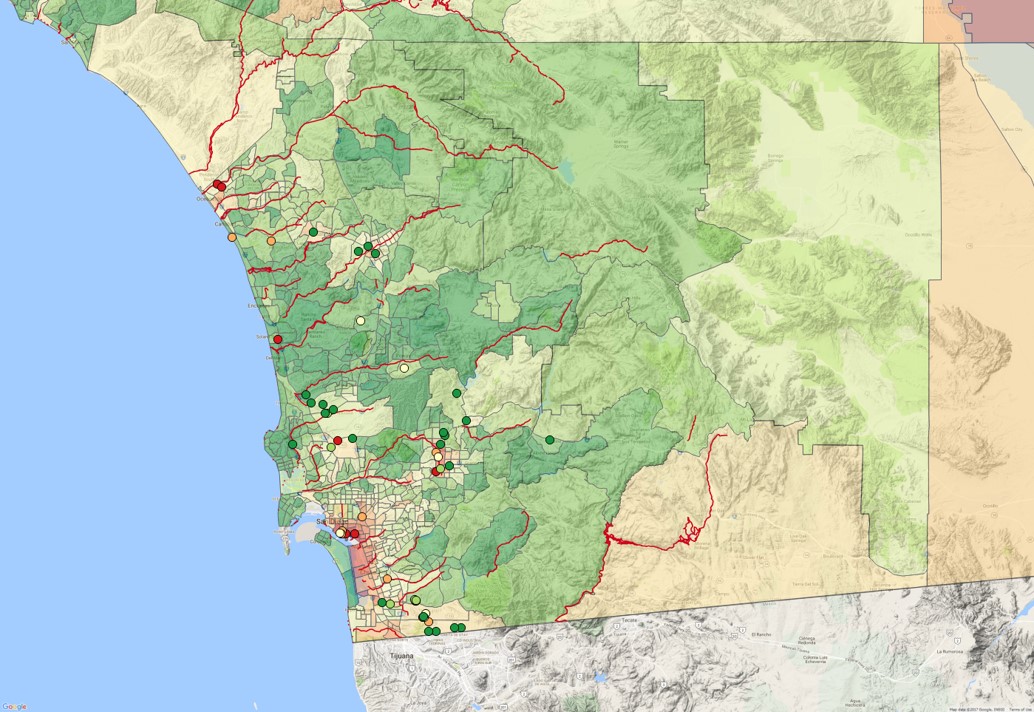
Enforcement database tool helps California Waterkeepers map industrial pollution hotspots in San Diego
The State Water Board’s job is to keep California’s coast, bays, and rivers clean and safe for all to enjoy. They do this by administering and overseeing permits and policies to limit the flow of pollution, in keeping with state and federal clean water laws. Waterkeepers and other advocates work hard to strengthen these rules and monitor local waterways to highlight pollution from industrial, agricultural, and other facilities that are not following them.
Despite strong clean water laws, over 90% of California rivers are too polluted for swimming, drinking, or fishing. Laws are only as effective as their enforcement and implementation, and both are severely lacking in California. Ninety-nine percent of State Water Board enforcement actions are administrative, meaning that they lead only to a warning by phone call or staff letter rather than a penalty or clean-up schedule.
Meaningful enforcement of water quality standards largely falls to citizen watchdog organizations like the Waterkeepers, and we have had some important successes. San Diego Coastkeeper’s lawsuit against the city of San Diego resulted in a 90% reduction in sewage spills, ending San Diego’s “sewage-spill-a-day” reputation. Orange County Coastkeeper’s enforcement program has helped over 60 industrial facilities come into water quality compliance. And Los Angeles Waterkeeper has had major legal victories that resulted in a substantial improvement of coastal water quality, including a dramatic reduction in sanitary sewer overflows in Malibu, and improvements to industrial pollution safeguards at local scrap metal recycling and auto dismantling yards.
In order to maximize Waterkeepers’ limited resources for these kinds of cases, San Diego Coastkeeper developed a tool to help identify the most egregious industrial polluters. The enforcement tool is a database and mapping system that utilizes publicly available, self-reported stormwater data and assigns a score based on the frequency and magnitude of water quality violations. Those scores are then exported into a map to show where violations are occurring, determine the distance between the violation and contaminated waterways, and pinpoint violations occurring in disadvantaged communities.
In response to California Coastkeeper Alliance advocacy, the State Water Board is now developing a stormwater enforcement tool, using the Waterkeepers’ tool as a model, that will be deployed in San Diego, Los Angeles, and the Central Valley starting in mid-2018. But the State and Regional Water Boards need to make many more changes so that our water laws and policies are being fairly and effectively enforced statewide. Our permits and policies should be crafted with enforcement in mind and our State and Regional Water Boards should identify priorities and metrics against which progress can be measured. Finally, enforcement actions should be prioritized in underserved communities that have historically suffered the most from pollution.
California has some of the toughest water quality and ocean protection laws on the books. But if these laws are not meaningfully enforced, they are of little value to the ecosystems and communities they are designed to protect. Now is the time for the state to make enforcement a priority and hold polluters accountable. The State Water Board’s new analytical enforcement tool is a great start, but deeper reforms are needed. Work is underway through our Clean Water Accountability Project to do just that.

Executive Director Sean Bothwell leads CCKA’s initiatives to fight for swimmable, fishable, and drinkable waters for all Californians.



